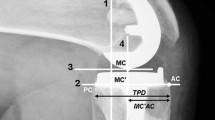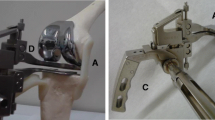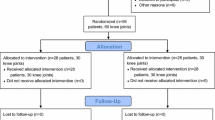Abstract
The objective of this study was to investigate the range of motion (ROM) of the knee before and four years after total knee arthroplasty (TKA) with a mobile or fixed type of platform and to prospectively evaluate whether there was a difference in ligament balance between the platform types. The subjects were 68 patients involving 76 joints. The mobile type was used in 31 joints and fixed type in 45 joints by employing a prospective randomised method. The passive maximum ROM was measured using a goniometer before and four years after surgery. Also, the intraoperative knee ligament balance was measured. The postoperative extension ROM was significantly improved after TKA using a mobile bearing type compared with that employing a fixed bearing type. In TKA using the former, the intraoperative gap difference was not related to the postoperative flexion angle of the knee. However, they were related in TKA using a fixed bearing type, with a positive correlation regarding the flexion gap.





Similar content being viewed by others
References
Baldini A, Scuderi GR, Aglietti P, Chalnick D, Insall JN (2004) Flexion-extension gap changes during total knee arthroplasty: effect of posterior cruciate ligament and posterior osteophytes removal. J Knee Surg 17:69–72
Bellemans J, Banks S, Victor J, Vandenneucker H, Moemans A (2002) Fluoroscopic analysis of the kinematics of deep flexion in total knee arthroplasty. Influence of posterior condylar offset. J Bone Joint Surg Br 84:50–53
Dennis DA, Clayton ML, O’Donnel S, Mack RP, Stringer EA (1992) Posterior cruciate condylar total knee arthroplasty. Average 11-year follow-up evaluation. Clin Orthop 281:168–176
Dennis DA, Komistek RD (2006) Mobile-bearing total knee arthroplasty: design factors in minimizing wear. Clin Orthop 452:70–77
Hanratty BM, Thompson NW, Wilson RK, Beverland DE (2007) The influence of posterior condylar offset on knee flexion after total knee replacement using a cruciate-sacrificing mobile-bearing implant. J Bone Joint Surg Br 89:915–918
Lädermann A, Lübbeke A, Stern R, Riand N, Fritschy D (2008) Fixed-bearing versus mobile-bearing total knee arthroplasty: a prospective randomised, clinical and radiological study with mid-term results at 7 years. Knee 15:206–210
Meneghini RM, Ritter MA, Pierson JL, Meding JB, Berend ME, Faris PM (2006) The effect of the Insall-Salvati ratio on outcome after total knee arthroplasty. J Arthroplasty 21:116–120
Nicholls RL, Schirm AC, Jeffcote BO, Kuster MS (2007) Tibiofemoral force following total knee arthroplasty: comparison of four prosthesis designs in vitro. J Orthop Res 25:1506–1512
Parsley BS, Conditt MA, Bertolusso R, Noble PC (2006) Posterior cruciate ligament substitution is not essential for excellent postoperative outcomes in total knee arthroplasty. J Arthroplasty 21:127–131
Rand JA, Ilstrup DM (1991) Survivorship analysis of total knee arthroplasty. Cumulative rates of survival of 9200 total knee arthroplasties. J Bone Joint Surg Am 73:397–409
Ridgeway S, Moskal JT (2004) Early instability with mobile-bearing total knee arthroplasty: a series of 25 cases. J Arthroplasty 19:686–693
Ritter MA, Harty LD, Davis KE, Meding JB, Berend ME (2003) Predicting range of motion after total knee arthroplasty. Clustering, log-linear regression, and regression tree analysis. J Bone Joint Surg Am 85-A:1278–1285
Schai PA, Thornhill TS, Scott RD (1998) Total knee arthroplasty with the PFC system. Results at a minimum of ten years and survivorship analysis. J Bone Joint Surg Br 80-B:850–858
Sharma A, Komistek RD, Scuderi GR, Cates HE Jr (2007) High-flexion TKA designs: what are their in vivo contact mechanics? Clin Orthop 464:117–126
Wallace AL, Harris ML, Walsh WR, Bruce WJ (1998) Intraoperative assessment of tibiofemoral contact stresses in total knee arthroplasty. J Arthroplasty 13:923–927
Watanabe T, Tomita T, Fujii M, Hashimoto J, Sugamoto K, Yoshikawa H (2005) Comparison between mobile-bearing and fixed-bearing knees in bilateral total knee replacements. Int Orthop 29:179–181
Whiteside LA (1994) Cementless total knee replacement. Nine- to 11-year results and 10-year survivorship analysis. Clin Orthop 309:185–192
Wyss T, Schuster AJ, Christen B, Wehrli U (2008) Tension controlled ligament balanced total knee arthroplasty: 5-year results of a soft tissue orientated surgical technique. Arch Orthop Trauma Surg 128:129–135
Author information
Authors and Affiliations
Corresponding author
Rights and permissions
About this article
Cite this article
Higuchi, H., Hatayama, K., Shimizu, M. et al. Relationship between joint gap difference and range of motion in total knee arthroplasty: a prospective randomised study between different platforms. International Orthopaedics (SICOT) 33, 997–1000 (2009). https://doi.org/10.1007/s00264-009-0772-7
Received:
Revised:
Accepted:
Published:
Issue Date:
DOI: https://doi.org/10.1007/s00264-009-0772-7




